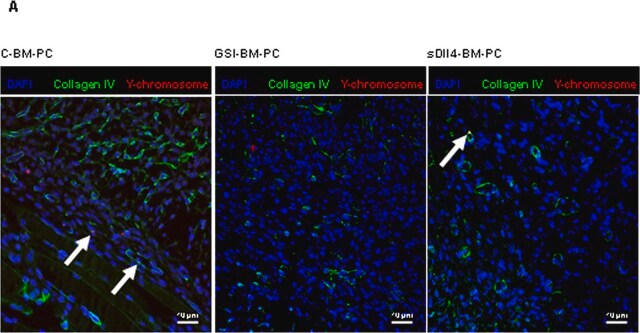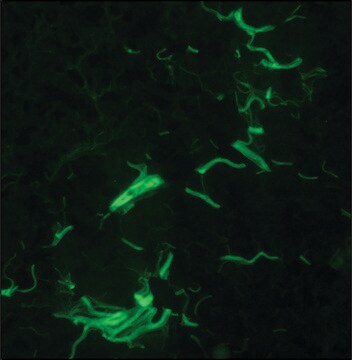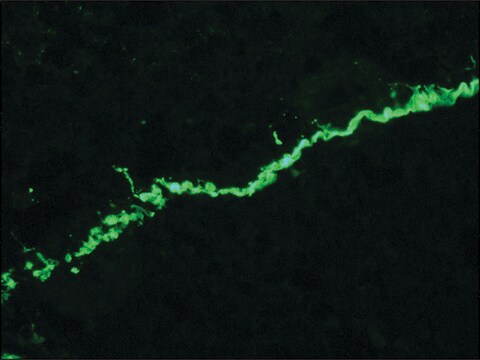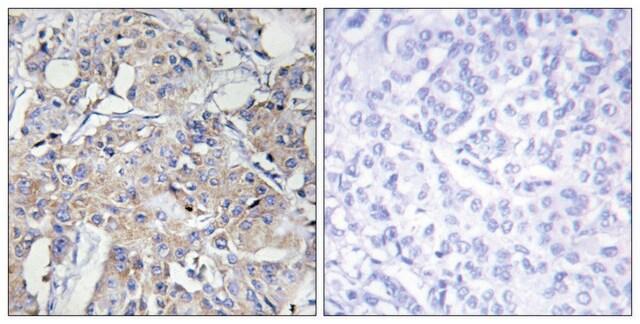AB7821
Anti-Collagen Type VI Antibody
serum, Chemicon®
Sign Into View Organizational & Contract Pricing
All Photos(1)
About This Item
UNSPSC Code:
12352203
eCl@ss:
32160702
NACRES:
NA.41
Recommended Products
biological source
rabbit
Quality Level
antibody form
serum
antibody product type
primary antibodies
clone
polyclonal
species reactivity
human
manufacturer/tradename
Chemicon®
technique(s)
ELISA: suitable
immunohistochemistry: suitable
NCBI accession no.
UniProt accession no.
shipped in
dry ice
target post-translational modification
unmodified
Gene Information
human ... COL6A1(1291)
Specificity
Human collagen type I <0.5%
Human collagen type II <0.5%
Human collagen type III <0.5%
Human collagen type IV <0.5%
Human collagen type V 5%
Human collagen type VI 100%
Human fibronectin <0.5%
Human albumin <0.5%
Human immunoglobulin <0.5%
Human collagen type II <0.5%
Human collagen type III <0.5%
Human collagen type IV <0.5%
Human collagen type V 5%
Human collagen type VI 100%
Human fibronectin <0.5%
Human albumin <0.5%
Human immunoglobulin <0.5%
Immunogen
Human placental collagen type VI
Application
Anti-Collagen Type VI Antibody is an antibody against Collagen Type VI for use in ELISA, IH.
Immunohistochemistry: 1:10-1:40 dilution of reconstitute for indirect immunofluorescent staining of frozen tissue sections.
ELISA: 1:10,000 dilution of reconstitute for ELISA on human collagen type VI.
Optimal working dilutions must be determined by the end user.
ELISA: 1:10,000 dilution of reconstitute for ELISA on human collagen type VI.
Optimal working dilutions must be determined by the end user.
Physical form
Pooled antisera was cross-absorbed against immobilized human serum proteins and collagen types IV and V. The IgG fraction was then precipitated with ammonium sulfate and subsequently dialyzed. Lyophilized from 500μL of 10mM Na-phosphate, 150mM NaCl, pH 7.5 with 0.1% mannitol.
Storage and Stability
Maintain lyophilized at -20°C for up to 12 months. Reconstitute with 500uL of distilled water or saline. Store reconstitute between 2 and 8°C for up to two months. Remove any insoluble material by microcentrifugation before use.
Legal Information
CHEMICON is a registered trademark of Merck KGaA, Darmstadt, Germany
Not finding the right product?
Try our Product Selector Tool.
Storage Class
11 - Combustible Solids
wgk_germany
WGK 1
flash_point_f
Not applicable
flash_point_c
Not applicable
Certificates of Analysis (COA)
Search for Certificates of Analysis (COA) by entering the products Lot/Batch Number. Lot and Batch Numbers can be found on a product’s label following the words ‘Lot’ or ‘Batch’.
Already Own This Product?
Find documentation for the products that you have recently purchased in the Document Library.
Cristina Herrera et al.
PLoS neglected tropical diseases, 10(4), e0004599-e0004599 (2016-04-02)
The time-course of the pathological effects induced by the venom of the snake Bothrops asper in muscle tissue was investigated by a combination of histology, proteomic analysis of exudates collected in the vicinity of damaged muscle, and immunodetection of extracellular
S San Martin et al.
Journal of tissue engineering and regenerative medicine, 7(1), 10-19 (2011-11-05)
Several studies have developed efficient oral mucosa constructs using different types of scaffold. However, the changes in the morphology and gene and protein expression profile that could occur in these artificial constructs remain unknown. This study compared the histology and
Three novel collagen VI chains with high homology to the alpha3 chain.
Gara, SK; Grumati, P; Urciuolo, A; Bonaldo, P; Kobbe, B; Koch, M; Paulsson, M; Wagener, R
The Journal of Biological Chemistry null
Ayman M Ibrahim et al.
Breast cancer research : BCR, 23(1), 90-90 (2021-09-28)
During pregnancy, the mouse mammary ductal epithelium branches and grows into the surrounding stroma, requiring extensive extracellular matrix (ECM) and tissue remodelling. It therefore shows parallels to cancer invasion. We hypothesised that similar molecular mechanisms may be utilised in both
Ai Fujii et al.
Scientific reports, 10(1), 22206-22206 (2020-12-19)
Collagen type VI (COL6) deposition occurs in various glomerular diseases, causing serious pathological damage like nodular lesions. However, the mechanisms underlying the deposition of COL6 remain unclear. In renal biopsy samples, immunohistochemical analyses revealed that COL6 and phosphorylated histone H2AX
Our team of scientists has experience in all areas of research including Life Science, Material Science, Chemical Synthesis, Chromatography, Analytical and many others.
Contact Technical Service







